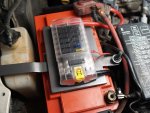calicamper
Expedition Leader
Dan just from a battery health perspective and ease of use I'm running power to a small 6 fuse box from the controller so I can let the controller manage battery life/charge health. My use will be simple LED lighting and very basic small item charging like GoPro camera, Cell phone etc. So I will be in the 20amp and under range easily. I do plan on inline fuses between my controller and the load wiring to my fuse block as a safety for the controller. The Solar and battery connections I wont fuse those. My primary concern is causing a load issue with the cheap LED gear or a faulty charging hub or ground issue that damages the load side of the controller. So by placing a 15amp or maybe 20amp fuse between the controller and my load items I can prevent any goofy issues were the total load passed through by my 6 fuse block does not blow a fuse. I'm going to run 2 5amp fuses in my block for the two LED power sources they pull about 2amps max tested that will go on each of the two power sources from the fuse block. Then I will run a 10amp fuse on my charging hub via the fuse block. No fridge yet any way ;-)


